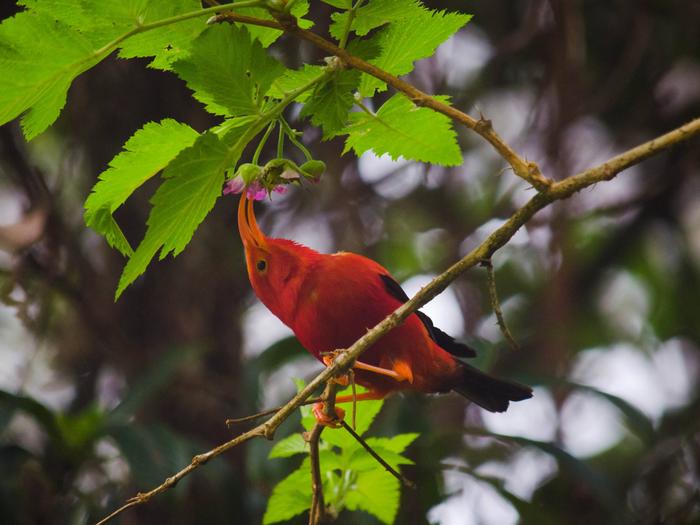Hakalau Forest National Wildlife Refuge
Fish and Wildlife Service, Hawaii.
Hakalau Forest NWR contains some of the finest remaining stands of native montane rain forest in Hawai‘i. The slopes below 4,000 feet receive very high rainfall - 250 inches annually. Bogs, fern patches, and scrubby forest dominate this area which is dissected by numerous deep gulches. Rainfall decreases to about 150 inches at elevations above 4,500 feet, where majestic koa and red-blossomed ‘ōhi‘a trees form a closed-canopy forest. Further upslope, above 6,000 feet, rainfall decreases to 100 inches or less and native forest merges into abandoned pastureland where alien grasses and weeds, introduced as forage for cattle, are the dominant vegetation. Since 1989, over 400,000 koa, ‘ōhi‘a, and other native plants have been planted in this area as part of the refuge's reforestation program.
In 1997, the U.S. Fish and Wildlife Service purchased approximately 5,300 acres of land to create the Kona Forest Unit of Hakalau Forest NWR. The Kona Forest Unit includes lands within the Ho‘okena and Kalahiki land divisions on the western slopes of Mauna Loa, at elevations between 2,000 and 6,000 feet. Kona Forest Unit is located approximately 23 miles south of Kailua-Kona.
At the lower elevations - 2,000 to 3,600 feet - the forest is predominately ‘ōhi‘a trees with an understory of nonnative trees and shrubs, such as christmasberry, clidemia, an strawberry guava. Above 3,600 feet, the invasive trees and shrubs drop out and the forest is dominated by ‘ōhi‘a and koa trees with an understory of ferns and native flora. A remnant of dry ‘ōhi‘a forest is found at the highest elevations and includes sandalwood and māmane.
The primary purpose for establishing the Kona Forest Unit is to protect, conserve, and manage this native forest for threatened or endangered species. Of particular concern was the ‘alalā (Corvus hawaiiensis), whose wild population, known only from the west side of the Big Island, gradually declined to only a single pair in 2002. After 1993, the wild population of ‘alalā was observed intensively, as the number of birds gradually declined to a single pair in 2002, and were not seen after June of that year. As of 2008, approximately 50 ‘alalā are in captivity at the Keauhou and Maui Bird Conservation Centers on Hawai‘i and Maui islands, respectively. Once the Kona Forest Unit is fenced, feral ungulates removed, and vegetation and habitat restored, progeny from these captive birds may be released into the Kona Forest Unit.
The Kona Forest Unit also offers protected areas for other endangered species, including the Hawai‘i ‘ākepa, (Loxops coccineus), Hawai‘i creeper (Oreomystis mana), ‘akiapōlā‘au (Hemignathus munroi), ‘io (Hawaiian hawk), and ‘ōpe‘ape‘a (Hawaiian hoary bat), as well as, several endangered plants and an insect.
Nearby Activities
- Environmental Education
- Hiking
- Photography
- Wildlife Viewing
Directions
The refuge office is located at 60 Nowela Street, Suite 100. Only the Upper Maulua Unit of Hakalau Forest Refuge is open to the public, and only on weekends and holidays for hiking and photography. There are no interpretive signs, bathrooms, trails, or parking lots. Visitors must call the refuge office (808-443-2300) a week before their intended visit to get the combination to a locked gate through which they let themselves in and out. A brochure will be mailed which describes the Maulua Unit, and our public access program plus a general brochure which describes the entire refuge and our management programs. The Upper Maulua Unit can be reached from Hilo or Kona via the Saddle Road (Highway 200): Near the 28-mile marker on the Saddle Road, turn north on the paved Mauna Kea Summit Road and proceed two miles. Turn right (east) across a cattle guard and onto Keanakolu Road (also known as Mana Road). Drive approximately 16.5 miles on this gravel road to the Maulua Gate. A four-wheel-drive vehicle is required for the long and bumpy drive which takes about two hours each way from Hilo or Kona. Contact the refuge office for reservations and current road conditions. Due to its remote location and poor roads, the Upper Maulua Unit gets only a handful of visitors each month.

